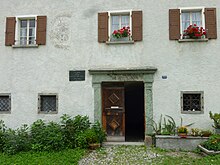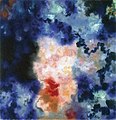Augusto Giacometti
Antonio Augusto Giacometti (born August 16, 1877 in Stampa , Bergell , † June 9, 1947 in Zurich ) was a Swiss painter . He is regarded as an outstanding painter in the succession of Art Nouveau and Symbolism , as a innovator of glass painting and an exponent of monumental wall painting and designer of posters that have become popular .
life and work
Augusto Giacometti is part of the famous Giacometti painting dynasty . Growing up just a few meters from his cousin Giovanni Giacometti's house , he began to devote himself to painting at an early age. He completed his training as a drawing teacher between 1894 and 1897 at the Zurich School of Applied Arts . After studying with Eugène Grasset in Paris from 1897 to 1901, as well as residing in Florence and Zurich , he finally settled in Zurich from 1915.
In 1917 Giacometti met the Dadaists Tristan Tzara , Marcel Janco , Sophie Taeuber-Arp and Hugo Ball . He took part in the 8th Dada soirée in the Zurich Kaufleutensaal and became a member of the artist group “Das Neue Leben” (1918–1920).

With the execution of his design for the entrance hall of the police station in Amtshaus I in Zurich between 1923 and 1925, Giacometti succeeded in one of his most important works, also known as the Giacometti Hall . Thanks to this order, which immediately attracted a lot of attention, the way to further important commissioned work was paved for him.
He was one of the first artists of the 20th century who gave painting almost complete autonomy and dared to take the step into non-representationalism. Giacometti subsequently became a great colorist . On his tombstone it says: "Qui riposa il maestro dei colori" (German: "Here the master of colors rests").
In 1929 he created the colored glass window in the east wall of the Protestant town church in Frauenfeld, in 1933 the choir windows in the Grossmünster in Zurich, in 1937 the choir windows of the Adelboden village church and in 1945 a church window in the Fraumünster in Zurich.
Both stylistically and in the choice of his motifs, Giacometti had a great influence on the German painter August Babberger .
gallery
- Works by Giacometti
Giacometti Hall in the Police Station Amtshaus I in Zurich (1923–1925)
Giacometti's Window in the Choir of the Great Minster in Zurich (1933)
Stained glass window in the church of S. Giorgio near Borgonovo (1935), where Giacometti is buried
Stained glass window in the Fraumünster in Zurich: Heavenly Paradise (1945)
St. Johann in Davos , Giacometti window
Exhibitions
- 2014/2015: The color and me. Augusto Giacometti , Kunstmuseum Bern
literature
- Elisabeth Ellenberger: Augusto Giacometti. In: Historical Lexicon of Switzerland . December 11, 2006 , accessed March 3, 2020 .
- Ulrich Gerster: The church windows of the Great Minster of Zurich. Augusto Giacometti - Sigmar Polke. (Swiss Art Guide, No. 915, Series 92). Ed .: Society for Swiss Art History , Bern 2012, ISBN 978-3-03797-071-3 .
- Beat Stutzer, Lutz Windhöfel : Augusto Giacometti. Life and work . Editor Urs Waldmann, illustrators Alexander Troehler and Reinhard Zimmermann, Bündner monthly publishing house Desertina 1991, ISBN 3-9052-4122-6 .
Web links
- Beat Stutzer: Giacometti, Antonio Augusto. In: Sikart
- Publications by and about Augusto Giacometti in the Helveticat catalog of the Swiss National Library
- Literature by and about Augusto Giacometti in the catalog of the German National Library
- Augusto Giacometti's estate at the Swiss Institute for Art Research
- Research project «Catalog raisonné Augusto Giacometti» of the Swiss Institute for Art Research
- Martina Medolago: «The color and me». Augusto Giacometti and Berna.
- E. Frölicher: Augusto Giacometti. In: Das Werk: Architektur und Kunst (Volume 4, Issue 4, 1917). Verlag "Das Werk" A.-G. Bümpliz / Bern, 1917, p. 7 , accessed on April 30, 2019 .
Individual evidence
- ↑ Augusto Giacomett estate , sik-isea.ch, accessed on June 20, 2012
- ↑ See Sikart web link
- ^ Erwin Poeschel, Architecture and Art, 1926: The frescoes by Augusto Giacometti in the Amsthaus in Zurich. Retrieved October 6, 2019 .
- ^ Announcement on the exhibition , accessed on July 19, 2014.
| personal data | |
|---|---|
| SURNAME | Giacometti, Augusto |
| BRIEF DESCRIPTION | Swiss painter |
| DATE OF BIRTH | August 16, 1877 |
| PLACE OF BIRTH | Stampa |
| DATE OF DEATH | June 9, 1947 |
| Place of death | Zurich |











